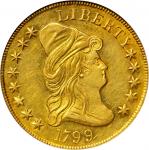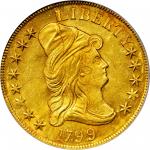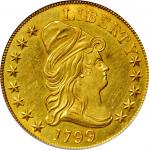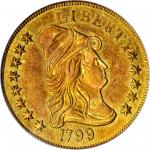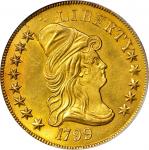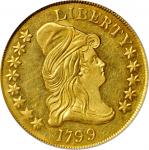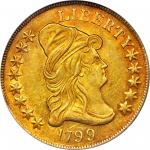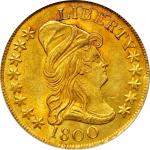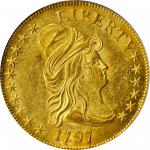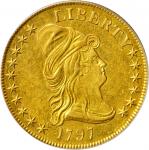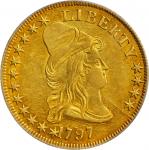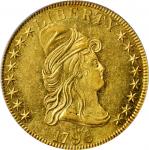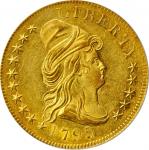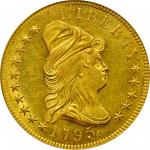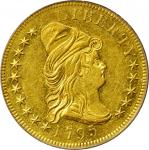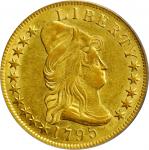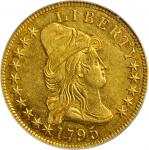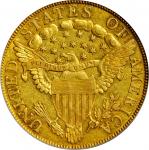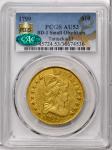1799 Capped Bust Right Eagle. BD-1, Taraszka-13. Rarity-7. Small Obverse Stars. AU-53 (PCGS). CAC.Type and Style: Type II: Capped Bust Right, Heraldic Eagle. Style VI: Head of 1795 with 13 small stars arranged eight left, five right; Reverse of 1799 with 13 small stars in the field below the clouds and a short, thick neck on the eagle. The head and eagle punches are attributed to hubs prepared by Robert Scot.Die Variety: BD-1, Taraszka-13, Breen-Unlisted (6-A), HBCC-3182. This variety represents the only use of this obverse die in the Capped Bust Right eagle series and the first of four uses of this reverse die. The obverse is identifiable by a wide, evenly spaced date with one point of star 9 touching the letter Y in LIBERTY under the right serif, one point of star 13 close to the end of Libertys bust, and repunching to star 12. On the reverse, the lowermost arrow head is under the extreme left edge of the letter N in UNITED, a leaf tip just touches the center of the letter I in UNITED, the lowermost berry is centered under the final letter A in AMERICA, a faint, jagged die line originates at the border above the right edge of the letter O in OF, bisects that letter and terminates at cloud 5, and there are small die rust lumps between the letters UN in UNITED and within the top of the N.Die State: BD Die State b/b. This is the typically encountered die state of this variety, Die State a/a with no clashing, cracks or lapping on either the obverse or reverse currently unknown, and only one example known with an earlier state of the obverse (see below). On the obverse, prominent die cracks are evident from the border through star 8 into the field parallel to the back of the cap and from the border through the letter L in LIBERTY and the cap into Libertys face behind the eye. The reverse is also cracked, albeit much less significantly with a noncontiguous rust-like crack or ridge within the letter C in AMERICA, through the adjacent A, the eagles left talon, the stem end and into the tail feathers.Estimated Mintage for the Issue: The conventionally accepted mintage has been 37,449 coins for the 1799 Capped Bust Right eagle issue, based on Walter Breens assumption that all of the coins delivered between May 14, 1799, and September 4, 1800, were from 1799-dated dies. After careful study, Dannreuther provides a revised range of 31,750 to 46,250 pieces produced, the lower estimate allowing for the possibility that some 1797 BD-3 and/or BD-4 coins were included in Breens 37,499-piece mintage, and the upper estimate allowing for the possibility that some 1799-dated eagles were also included in later deliveries.Estimated Mintage for the Variety: Dannreuther estimates that 250 to 750 examples were coined from the 1799 BD-1 dies.Estimated Surviving Population for the Variety: Only five to seven coins are believed extant in all grades, per the estimate of John Dannreuther. We have positively confirmed the existence of only five different specimens (see below).Strike: Both sides display a boldly executed strike, the reverse with particularly sharp detail throughout much of the eagles plumage. The high points of Libertys portrait reveal light rub that explains the AU-50 grade from PCGS, but the more recessed hair strands are crisply delineated. The borders are fully and uniformly denticulated around both sides, and all other features are boldly to sharply defined.Surfaces: Handsome olive-gold patina is highlighted by some brighter golden-yellow as well as subtle pinkish-rose around the peripheries. Ample satin to semi-prooflike luster remains, the latter particularly pronounced in the reverse field. The appearance is quite smooth for the assigned grade, identifying features confined to a tiny nick in the right obverse field before Libertys chin and an extremely faint pin scratch along the lower reverse border after the final letter A in AMERICA.Commentary: After delivering 842 eagles on February 28, 1798, the Mint ceased production of this denomination until May 14, 1799. The first 1799-dated coins introduced several new features that would become standard through the end of the Capped Bust Right series in 1804. For the obverse, the Mint finally settled upon the 8x5 arrangement for the 13 stars. The reverse features the first use of Robert Scots Heraldic Eagle hub, which differs from the various John Smith Gardner hubs in several key aspects. The stars are in a distinct and even arc pattern, there are four vertical lines in the six shield stripes, the eagle has a short, thick neck, and there are three as opposed to two rows of feathers in the eagles tail. BD-1 is undoubtedly the first 1799-dated variety produced, for there is a unique copper die trial known. That coin, attributed as Judd-26 and Pollock-44, most recently appeared at auction in our (Bowers and Merenas) Salisbury and Woods Collections sale, September 1994, lot 1023. It represents the Mints initial test of the new Scot reverse, the chisel marks on the reverse probably added to prevent the coin from being gilt and passed in commercial channels as a gold striking. For many years, this copper die trial was the only known example from the BD-1 dies. The earliest known confirmation of the 1799 BD-1 dies in gold was made by Harry W. Bass, Jr. when he acquired his example from Lester Merkins February 1972 sale. The cataloger erroneously attributed the coin as Breen 1-A, but was aware that the obverse die cracks were unpublished and, thereby, significant. Today, as stated, we know of only five specimens that are positively confirmed to exist:1 - AU-55. Ex Superiors Pre-Long Beach Coin Sale of October 2001, lot 2874, unattributed.2 - PCGS AU-53. Ex Heritages ANA Sale of July 1994, lot 5817, incorrectly attributed as Breen 1-A; Anthony J. Taraszka. The present example.3 - EF or finer. Ex Lester Merkins sale of February 1972, lot 433, incorrectly attributed as Breen 1-A; Harry W. Bass Core Collection.4 - NCS AU Details--Improperly Cleaned. Ex Ira & Larry Goldbergs sale of the Benson Collection, Part III, February 2003, lot 2083; Heritages Signature Coin Auction of March 2009, lot 3057. This coin is the earliest known die state of the variety, the obverse not perfect, but with only a single, short crack from the border to star 8. Either this coin is BD Die State a/a (i.e., no perfect obverse die state coins were ever produced) or it is an intermediate Obverse Die State a-b.5 - AU, Scratched and Tooled. Ex Ira & Larry Goldbergs Pre-Long Beach Sale of February 2006, lot 1232.Discounting only the Proof 1804 BD-2 Plain 4, which is a special non-contemporary presentation issue struck circa 1834 to 1835, 1799 BD-1 is the rarest die variety in the Capped Bust Right eagle series. The elusiveness of examples is clearly due to the early break up of the obverse die, which resulted in a brief press run with very few examples struck. The reverse, as related above, remained in use for three subsequent die pairings. A leading highlight of the present collection, this presents an important opportunity for early gold variety specialists. This coin is included in the list of Significant Specimens for the variety in the Taraszka early eagle reference.From the Anthony J. Taraszka Collection. Earlier from Heritages ANA Sale of July 1994, lot 5817. The plate coin for the die variety in the book United States Ten Dollar Gold Eagles: 1795-1804 by Anthony J. Taraszka.

